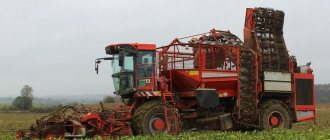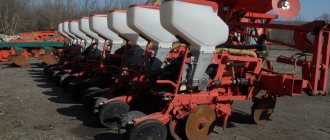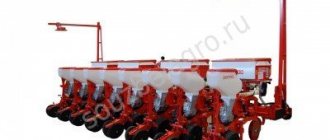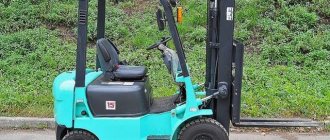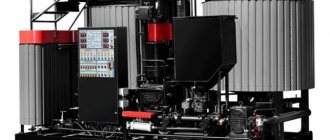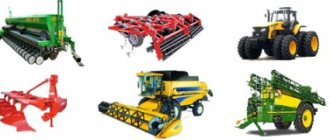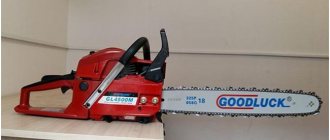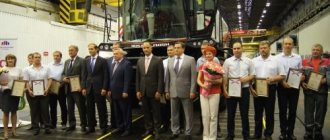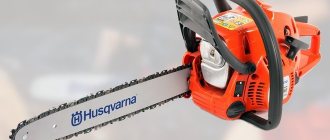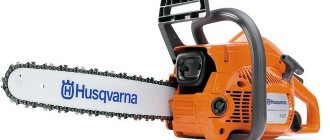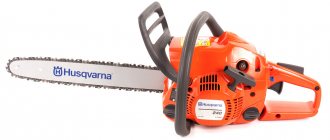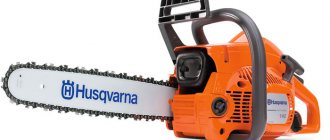Today, among the numerous competitors in self-propelled beet harvesting equipment, two German manufacturers stand out for their quality and productivity:
The Holmer company with the Terra Dos, Terra Felis, Terra Felis 2 combine (Holmer, Holmer, Terra Dos, Terra Felis, Terra Felis 2) and the Ropa company with the Euro Tiger, Euro Maus 3 combine (Ropa, Euro Tiger, Euro Maus 3).
The question arises: who is better? Here are 10 answers to this question:
1. Price:
Holmer combine is 40,000 euros lower than the Ropa combine!
2. Dimensions and weight:
Ropa Tiger weighs 8 tons more than Holmer Terra Dos!
8 tons more metal, 8 tons more equipment that breaks down, requires maintenance and costs money! Due to the size of the Ropa Tiger, it is very difficult to find trawls to transport them, and the transportation itself is much more expensive! 3. Fuel consumption:
this is the main argument in favor of Holmer Terra Dos; in the Western market, Holmer takes first place by a large margin in terms of sales.
15-20 liters of fuel savings on each harvested hectare (Holmer consumption - 33 liters, Ropa - 55 liters!). Savings on Holmer are achieved by the so-called. “automatic” method - i.e. the working bodies take exactly as much energy as is needed at a given second of time; with an increased need for energy of any component of the mechanisms, there is a lightning-fast redistribution of energy in favor of this energy-intensive process, while the number of revolutions of the engine shaft remains constant, and as is known, the maximum fuel consumption occurs with an increase engine speed. 4. Harvesting speed:
The new Holmer uprooter has 15 to 20% greater beet throughput and eliminates the “hopper size advantage” (and then only on large plots), with medium and small field sizes using the Holmer combine in the same amount of time ( including stops for unloading) you can harvest more (!) than with a Ropa combine.
At the edge of the field, when turning, the large, heavy Rope needs more time and more boundary to enter the field, which gives the Holmer Terra Dos, which has the optimal combination of size and power, a clear advantage. 5. Savings:
Costs per hectare of beets harvested on Holmer combines are 15-20% lower than on Ropa combines.
6. Harvesting quality:
The Holmer has a better view from the driver’s cabin to the lifter’s shares than the Ropa combine; the Holmer lifter has an impeccable, patented automatic digging depth operation in combination with a row guide and an autopilot, which give optimal harvesting results.
7. Quality of cleaning:
According to test results, root crops leaving the Holmer bunker have 5% less soil contamination than Ropa combines.
8. Maintenance:
Holmer has better access, inspection and maintenance of machine mechanisms than Ropa.
All Holmer working bodies have a hydraulic drive, which is durable and maintenance-free and has proven itself from the best side. On the Holmer Terra Dos combine, special modules adapted to the conditions of Russia and Ukraine have been developed and introduced (for example: topper cleaning hatches, a reinforced group of lifter gearbox bearings, etc.), Ropa combines are constantly supplied as standard, regardless of the operating markets. 9. Comfort:
On Holmer it is intuitive, easier, thanks to the ergonomic arrangement of levers and control buttons, driving the combine from a comfortable cabin.
10. Secondary market:
The used Holmer Terra Dos combine, after many years of operation, continues to remain a stable, sustainable equipment, which has higher demand in the market and, as a result, higher economic profitability than the Ropa combine, this is reflected in the prices for used combines from both manufacturers.
In addition to beet harvesters, peeler loaders are playing an increasingly important role in sugar beet harvesting. Among the manufacturers of sugar beet cleaners, there are 3 main ones: HOLMER, Ropa, Kleine
You can see the comparative characteristics of this equipment in the table: From this table it can be seen that, being one of the youngest in the production of loader-cleaners, the HOLMER company is today the most advanced in the technical equipment of the equipment it produces. Thanks to this, it is actively conquering the markets of Europe and Russia.
We hope you make the right choice ;)
Most of the negative reviews about six-row beet harvesters are usually associated with the following three reasons: higher initial cost, too long process of conversion from transport to working position, small bunker volume. As for the initial cost, a nine-row beet harvester, definitely more expensive.
However, compared to the six-row euro-Tiger modification, this difference is only 4%. Since a comparable cost structure consists of financing, insurance, registration procedures, driver salaries, and care and maintenance costs, the additional costs for the nine-row Euro-Tiger seem quite relative. According to Ropa, the nine-row modification of the beet harvester becomes more profitable than the six-row one after harvesting the first 500 hectares. With a nine-row beet harvester, you can’t just go on the road, at least in Western Europe. After all, with a row spacing of 45 cm, the overall width of 50 cm is 4.83 m. However, why can’t attaching and removing the header, which is quite acceptable in combine harvesters, be used in a beet harvester? In the euro-Tiger, Ropa has done almost everything possible to make mounting easy and quick. Here, first of all, it is worth mentioning the stable two-axis turning mechanism of the transport trolley with pneumatic brake (at an additional cost). The digging and topping unit is suspended at three points on a longitudinal beam located on top, then the topping chopper is raised vertically and fixed with two pins.
Before transporting the euro-Tiger, the two safety bolts must be removed and the lines disconnected. To do this, on the left side of the device there is an eight-channel multifunctional connector for the oil system and a separate plug for electrical wiring. In this case, using a wrench, you need to alternately disconnect the four hoses with a thickness of 1"/4 and 1"/2 inches located on the right side of the machine. For greater comfort, an assist clutch mechanism should appear here in the future. All lines are conveniently secured to the tubular frame, which is suspended during transport along with built-in floodlights and warning signs at the front of the euro-Tiger unit. During operation, the frame is fixed on the transport trolley using a special fastener. In general, attaching or removing the digging and topping unit takes from 8 to 10 minutes. Thanks to the rear view camera, the transport trolley can be quickly mounted behind the euro-Tiger. On the track, the trailer moves confidently behind the car, rear axle steering allows the 22-meter implement to fit into tight turns, and the rear view camera allows you to monitor everything that is happening. The beet bunker of the euro-Tiger combine, according to the company, holds 40 m - or 26 tons.
When operating the nine-row PR-XL digger (the P index stands for Paintner - named after the owner of Ropa, Hermann Painter), the bunker is filled after 1000 m. For longer distances, an additional truck will be required to remove the crop. On the one hand, this provokes additional costs. However, on the other hand, the issue of additional costs is controversial, since in this case it is possible to avoid machine downtime when unloading the bunker into piles (1 minute per 40 m3 plus time for driving to the pile and back). This method is often used to increase the efficiency of using equipment when threshing bread. We were able to see the significant benefits of a nine-row beet harvester when working with the PR-XL digging attachment. This is already noticeable when digging: thus, laying beets in piles can be done while driving in reverse on the headland, since with 18 rows or 8 meters there is sufficient space.
When turning at the edge of the field, when digging up long rows, as well as when laying beds, the euro-Tiger can move with a wheel track offset, which does not have such a detrimental effect on the soil structure. But a six-row car does not provide such an opportunity. In order to maintain a sufficient distance to the next row of beets when the row spacing does not exceed 3.50 m. 45 cm, the unit must be equipped with a side-shifting digging attachment. The new unit is also more versatile in terms of equipping it with front axle tires: along with the standard 800 tires (transport width - 3 m), it is possible to install tires of size 900/60 R 32 or 1050/50 R 32, which increase the supporting surface. What is the productivity of a nine-row beet harvester compared to a six-row one? To find out, we took a nine-row Euro-Tiger V8-3 XL and a Tiger V8-3 with a six-row PR unit into the same field and with the same driver. In our case, the productivity per unit area of a nine-row machine turned out to be 30-40% higher. To achieve the same productivity, a six-row combine would have to travel at significantly higher speeds, which would seriously affect processing quality.
However, the advantage achieved during the tests is provided not only by the larger working width: the six-row combine unloaded independently (about 400 m of empty run per hectare), and the transportation of beets to the piles from the nine-row machine was carried out by a dump truck (270 m of empty run per hectare). Of course, a six-row combine can also unload in parallel, so the increase in productivity per unit area depends on the quality of the beets being harvested. At the same time, it can be unequivocally stated that with an increased working width, an acceptable speed at a high level of productivity is more realistic. In most cases, the throughput of the machine is limited by the quality of digging and cutting the tops. Therefore, the theoretical throughput of the cleaning units of a six-row machine (according to Ropa 200 t/ha) is not fully used. Here again the advantage of the nine-row combine becomes obvious, since at the same optimal harvesting speed it has (theoretically) up to 50% increased throughput. And this ultimately means less fuel consumption per hectare.
What especially caught our attention. Until now, the stone protection system was a spring installed in front of the digger, which quickly clogged when there was a significant amount of weeds. However, thanks to the hydraulic protection system installed on the top of the shaking drive of the PR unit, these problems should be history. To facilitate maintenance, the topshopper can be raised up and locked in this position by pressing a button in the cabin or at the bottom near the stairs. This makes it easier to access the topping tool, as well as the cutters. According to Ropa, wear on the PR excavation unit is kept to a minimum. Here it is possible to adjust the tapered roller bearings of the drive of the vibrating shares and the digger gearbox. The excavation roller is optionally available with an additional coating to reduce wear on the roller surface. Electronics of the euro-Tiger V8-3: Ropa designers have developed a universal electronic system responsible for maintenance, control, analysis and automatic functions.
Results: With the new PR-XL digging and topping unit for the euro-Tiger V8-3 combine, Ropa has reached new horizons in beet harvesting. The developers have done everything necessary to speed up the process of converting the device from a working position to a transport position (with a trailed trolley). The attachment for digging up sugar beets makes it possible to use wider tires on the front axle and harvest with a track offset already at the edge of the field and when crossing rows. The driver receives improved visibility for optimal adjustment of the digging and cutting tools. At the same time, the maximum distance without unloading the bunker, compared to six-row modifications, is reduced by approximately 30%. As a result, a nine-row beet harvester is more dependent on an additional vehicle than a six-row beet harvester. If such a machine is present, the owner of the euro-Tiger V8-3 XL beet harvester can count on an increase in productivity, depending on the characteristics of the beets being harvested, by 20-40%.
The engineering company ROPA Fahrzeug-und Maschinenbau GmbH is a leader in the production and sales of beet harvesting equipment and components. The company was founded in 1986, but the history of the development of equipment, which later became known under the ROPA brand, began back in 1972, when the 25-year-old son of a small farmer from Bavaria, Hermann Paintner, constructed his first self-propelled beet harvester from used parts.
This six-row “giant” with a hopper capacity of 20 tons became the main topic of discussion among sugar beet growers, and literally made Sittelsdorf a center of pilgrimage for farmers.
The courage and innovation of the design ideas of Hermann Paintner, who had no technical education, was amazing. However, bold persistence in achieving this goal was crowned with success already in 1974. It was then that the first few units of Hermann Paintner's equipment were sold and he and his partner Mr. Rockermeyer ventured into small-scale production of beet harvesting machines.
Today, the ROPA brand, which is made up of two surnames Rockermeier & Paintner, is known throughout the world as a guarantor of quality, reliability and modern technology. Over more than 40 years of existence, ROPA beet harvesting equipment has undergone a number of enormous changes and, as a result, rightfully took a leading position in the agricultural market. ROPA technology is known not only at home in Germany, but throughout the world, due to the fact that ROPA branches exist in almost every corner of the globe where sugar beets are cultivated: central Europe, Russia, Ukraine, China, USA, UK, Turkey.
A subsidiary in Russia, ROPA Rus LLC, has existed since July 21, 2004. The most favorable geographical area was chosen for the location of production - the Lipetsk region, the Central Black Earth region, where about 70% of Russian beets are produced. The first combine harvester of the ROPA brand, then unknown to anyone on the Russian market, was imported from Germany to the farm of ZAO Ranenburg-Kompleks, headed by Petr Ivanovich Bykov. The combine showed its best performance already in the first season (over 10,000 hectares of beets were produced), but, like any equipment, it required service. The German manufacturer ROPA Fahrzeug-und Maschinenbau GmbH promptly responded to this problem. Thus, close contact was born, and, subsequently, it was decided to open a Russian representative office of ROPA. The interest in ROPA technology on the part of farmers is confirmed by figures: the company's turnover has doubled in the first 3 years since the company was founded. In 2007, a bilateral agreement was signed on the construction of the ROPA plant in the village. Roshchinsky, located in the new economic zone of the Central Black Earth region with further prospects for the development of sales, and the organization of production and assembly of ROPA equipment. Today, the ROPA plant in Russia is 2022 m² of a fully equipped modern logistics center, an installation workshop with an area of 3000 m², convenient office premises, and a developed dealer network throughout Russia.
Beet harvesters are agricultural machines for harvesting sugar and for its subsequent processing in production. This equipment is equipped with high-precision attachments and functional processing systems. Thanks to the presence of built-in units, the beet harvester is able to independently process the harvested crop and send the prepared raw materials to enterprises for further processing. These are machines with a supporting frame on pneumatic wheels and complex attachments that allow you to collect, clean and perform primary processing of beets.
Beet harvesters
The main means of harvesting beet plantations are combines. Despite the possibility of using separate trailed beet harvesting units for tractors, a significant part of the machines is a one-piece structure. The operating efficiency of such a unit reaches 96-98% of the total share of beets grown.
Most combine harvesters are equipped with a self-propelled chassis, on the chassis of which working units are hung or attached. Root crops are collected into bins of various sizes, from where they can be quickly loaded into transport equipment.
Principle of operation
Two main methods of operation of the beet harvesting unit have been developed. The tried and tested principle of operation is to extract root crops from the ground by holding them by the tops, which are cut off after the tuber is captured inside the machine.
Modern combine harvesters often use a different operating principle, in which beets are dug out of the ground without tops and subjected to additional processing (cleaning). Extraction is carried out through the operation of a complex of passive or active diggers located in several rows. This increases the operating speed of the movement and the cleaning efficiency in one pass.
The cut tops, depending on their further use, are disposed of in two ways. To obtain natural fertilizer, the tops are crushed and scattered against the direction of travel. Feed use of plant waste involves storage and unloading processes, accompanied by cutting.
Additional devices
Harvesting beets with a combine can be done with the installation of various types of attachments and This equipment is additional to the main worker and is aimed at increasing the overall productivity of beet harvesting equipment in a certain working area and reducing harvest time. Additional receiving bins or bins of increased volume, and trailers for transporting beets are used as additional devices. Installing reinforced wide knives allows you to cover a larger area in one pass. During the winter season, additional starting devices are used.
Design features
Regardless of the manufacturer and operating scheme of beet harvesting units, their design uses a common number of components and layout principles. A significant part of modern machines have two working units responsible for the assembly and processing of root crops. The first block is involved in digging up the beets, and their cleaning is carried out in the second block of the topping machine.
Tops are trimmed using devices of an active or passive cutting system. Active knives use an external power source and are usually represented by a rotating shaft with L-shaped knives.
The passive knife circuit works when the tuber is further fed into a storage container or transport. Units for additional pruning and cleaning of root crops contribute to increasing the cleanliness of work. Diagram of a beet harvester using the example of a self-propelled model E-684
1 — support-copying boxes; 2 — disk side shares; 3 - flat main shares; 4, 6 - first and second separator conveyors; 5 — soil grinder cylinders; 7 — guide fingers; 8 — topping roller; 9 — remote finger slide; 10 — potato drainage roller; 11 — unloading elevator.
Review of popular manufacturers
Domestic models of combine harvesters are represented mainly by outdated models, which are used in a number of small agricultural farms. The highest reliability and performance are found in foreign models that have different performance and price characteristics.
"Holmer"
The models of this beet harvesting equipment are distinguished by highly automated control and continue to be improved, not stopping at several successful designs. The latest samples have a three-axis design, which allows the use of more productive and heavier machines. An additional wheel pair ensures the installation of a spacious bunker.
High engine power (up to 600 hp) is combined with high efficiency and an effective hydraulic drive system. Automated control minimizes the participation of the operator, who only needs to control the cleaning process.
Technical characteristics of Holmer “Terra Dos” beet harvesters:
| Characteristics | T-3 | T4-30 | T4-40 (3 axles) | Unit measurements |
| Power | 480 | 626 | 626 | hp |
| Length | 12,6 | 12,94 | 12,94 | m |
| Width | 3 | 3,08-3,30 | 3.08-3.30 m | m |
| Height | 3,98 | 3,98 | 3,98 | m |
| Hopper volume | 28 | 30 | 45 | m3 |
| Speed (max) | 32 | 40 | 40 | km/hour |
| S(max) | 2.5 | 2.5 | 2.5 | ha/h |
Note. 1. S – productivity. Video review of the Holmer “Terra Dos” beet harvester:
"Gomselmash"
Belarusian combine harvesters are universal harvesting equipment, although they are poorly suited for working on fields of low bearing capacity (in mountainous areas). Modern models provide harvesting of root crops in one pass, performing digging, clearing the soil, trimming and spreading the tops.
The combines are distinguished by an effectively implemented bunker unloading system, capable of releasing 24 m3 of collected beets in one minute. If transport is available, root crops can be collected in the back of a car via a conveyor belt. Uniform distribution of beets during movement is ensured by an auxiliary auger system. The most common models KS-6B, MKK-6 and RKS-6 have similar characteristics and are not distinguished separately when sold.
The system for cutting tops and side shoots ensures maximum beet quality, while chopping and spreading the tops allows for uniform fertilization of the field. Prepared root crops are placed in a windrow, from which they are selected manually or using an automated system. The dumping of fodder tops can be carried out into nearby vehicles. Technical characteristics of Gomselmash models:
| Characteristics | KS-6B (MKK-6, RKS-6) | "PALESSE BS624" ("Polesie-624") | KSN-6 "Polesie" (trailer model) | Unit measurements |
| Power | 185 | 490 | — | hp |
| Length | 9,4 | 13,7 | 4,3 | m |
| Width | 3,5 | 3,8 | 3,4 | m |
| Height | 3,95 | 4 | 1,3 | m |
| Hopper volume | — | 24 | — | m3 |
| Speed | 5-11 (working) | 10(working)/25(transport) | 10 (working) | km/h |
| S | 0,78-1,82 | 1,1-2,65 | 0,95-1,95 | ha/h |
The video shows the PALESSE BS624 combine harvester in operation:
"Wik" (WIK)
They are a rare representative of non-self-propelled beet harvesting units. The hydraulic unit of the combines provides aggregation with most tractors (semi-trailer system). The machines are popular for periodic use or the need for unification with existing equipment on the farm.
Technical characteristics of the wik model:
| Characteristics | Indicators | Unit measurements |
| Power | 170 | hp |
| Length | 6,2 | m |
| Width | 4,8 | m |
| Height | 4,2 | m |
| Hopper volume | 4 | m3 |
| Speed | 6,5-7,8 | km/h |
| S | 1.6-2.1 | ha/h |
Technical data
DIMENSIONS
| LENGTH | 14.99 m |
| HEIGHT | 4.00 m (transport position) |
| WIDTH | 3.00 (6-row with a row spacing of 45 cm). 3.30 m (6 rows with a row spacing of 50 cm and variable 45-50 cm). |
| OWN WEIGHT | from 33,400 kg, depending on equipment |
| BUNKER CAPACITY | More than 43 m³ / 30 t. |
DIESEL ENGINE – 2 ENGINE TYPES TO CHOOSE
| VOLVO PENTA D16 700 hp / 515 kW |
|
| VOLVO PENTA D16 768 hp / 565 kW |
|
| FUEL TANK | 1320 l Diesel Fuel consumption display l/ha and l/h on the terminal |
| ADBLUETANK | 145 l AdBlue (only for Volvo Penta 700 PS/515 kW) |
COOLING SYSTEM
| CHARACTERISTICS |
|
MOTION DRIVE
| TRANSMISSION | Drivetrain with CVR continuously variable transmission for efficient power transfer. Consists of three hydraulic motors mounted on a summing gearbox. |
| CHARACTERISTICS | Stepless shifting from 0 km/h to 40 km/h without breaking traction (no need to change gear). 40 km/h in road driving mode at 1195 rpm, 17.5 km/h in the field at 1220 rpm. |
TIRE SET
| 1st AXIS | Michelin CerexBib 800/70 R38 (1.4 bar) |
| 2ND AND 3RD AXIS | Michelin MegaXBib 1050/50 R32 (1.9 bar) |
| OPTION | Michelin CerexBib 1000/55 R 32 (1.4 bar) |
| CHARACTERISTICS | The large tire contact area with the soil preserves the soil and ensures high operational reliability even in wet conditions and on slopes. |
CHASSIS – R-SOIL PROTECT
| CHARACTERISTICS | New chassis concept with swinging front axle combined with 2 hydraulically supported rear axles. |
| SLOPE LEVELING | Thanks to 6 hydraulic cylinders, the chassis tilts on both sides by approximately 10% towards the slope. |
| TRANSVERSE STABILIZATION | Transverse stabilization occurs due to hydraulic equalization of the oil volume in the stabilizing cylinders on one side of the machine |
Beet harvester Holmer T3
Beet harvesting machine from a German manufacturer, very reliable and productive:
- powerful 480hp engine;
- beet bunker – 28 cubic meters;
- automatic engine speed;
- fuel saving system;
- multi-mode operation of separating working bodies;
- ergonomic and comfortable driver's cabin;
- two-speed hydraulic transmission;
- Cruise control;
- speed 0-32 km/h;
- different types of topper cutters;
- set of cleaning rollers;
- programmable unloading height with memory function (up to 3.9 m);
- comfortable cabin with air conditioning, panoramic windows, sound insulation and on-board computer;
- floodlighting;
- segmented and spring-loaded screens with electronic remote calibration;
- rotation angle of 60 degrees.
Advantages:
- Ability to handle rocky soils, uneven terrain, snow-covered crops and cope with other non-standard cases;
- High productivity of large and individually adaptable working cleaning and uprooting organs;
- Low ground pressure due to offset wheels and wide tires;
- The ability to chop and immediately plow the tops if necessary, or collect them separately;
- Accurate cleaning of beets;
- Emptying storage in 40s;
- Acceleration of the unloading process due to the introduction of both transverse and longitudinal scraper bottoms;
- Optional connection of a vibrating coulter for working with heavily clogged root crops.
euro-Tiger V8-4
Technical data eT V8-4:
Front only euro-Tiger XL:
800/70 R 32 182 A8 or 900/60 R 32 176 A8
900/60 R 32 176 A8 or 1050/50 R32 178 A8
1050/50 R 32 178 A8
1000/50 R 25 172 A8
| Modifications: | eT V8-4a | eT V8-4b |
| Mercedes-Benz engine type: | Mercedes-Benz OM502LA.E3A/2 | Mercedes-Benz OM502LA.E3B/2 |
| Toxicity standard according to 97/68/EG: | Toxicity standard 3a | Toxicity standard 3b |
| Toxicity standards according to EPA (USA): | Toxicity standard 3 | Toxicity standard 41 |
| Power: | 444 kW | 440 kW |
| Max. torque: | 2700 Nm / 1300 rpm | 2800 Nm / 1300 rpm |
| Rated speed: | 1600 rpm | |
| Maximum speed: | 1690 rpm | |
| Type of drive: | 4-stroke diesel engine with direct injection | |
| Volume: | 15928 cm³ | |
| Drive drive: | Stepless hydrostatic with two operating modes | |
| Driving mode "Turtle": | 0 – 13 km/h | |
| Movement mode "Hare": | 0 - 20 km/h (or 25 km/h) | |
| 3 axles with mechanical drive and differential lock, with load adjustment on the 3rd axle and support for the swinging front axle. One additional axis (optional). | ||
| Own weight*: | 30950 kg to 32450 kg | 31100 kg to 32600 kg |
| Unladen weight (XL) without digger*: | 27000 kg to 27400 kg | 27150 kg to 27550 kg |
| Digger weight (XL) 9×45 cm (including BM): | 6970 kg | |
| Permissible tow load (only XL vehicles with tow bar): | 12000 kg | |
| Permissible total weight/axle load: | See label on combine | |
| Permissible front axle load (with 4 axles) | See label on combine | |
| Permissible axle load, rear (double axle) | See label on combine | |
| Fuel tank capacity: | 1440 l | 1380 l |
| AdBlue ® tank capacity: | — | 130 l |
| Fuel consumption: Average | 35 - 60 l/h | |
| Additional axis (optional): | 6.5 x 10 | |
| Performance: | up to 1.5 ha/h / with XL version up to 2.5 ha/h | |
| Generators: | 2 x 100 A | |
| Onboard voltage: | 24 V | |
| Voltage at rear 7-pin socket only (XL only): | 12 V | |
| Battery capacity: | 2 x 170 Ah | |
| Length (in transport position) of a 6-row combine: | 14950 mm | |
| Length (in transport position); only in Eastern Europe version with PBSOh | 15650 mm | |
| Length in transport position of the XL version with the digger removed: | 12500 mm | |
| Length in transport position of the XL version with transport trolley: | 22900 mm | |
| Height (in transport position): with digger PRh-45: with digger PRh-50 or PRh-V: XL version without digger: with tires 800/70 R32 (on the front axle): with tires 900/60 R32 (on the front axle) axles): with tires 1050/50 R32 (on the front axle): with tires 900/60 R32 (on the front axle) and middle axle with ET-60 mm disc: | 3000 mm 3299 mm 3000 mm3200 mm 3600 mm3260 mm | |
| Height (in transport position): | 4000 mm | |
| Height (in working position): with standard unloading conveyor: with extended unloading conveyor: | 5800 mm 6200 mm | |
| Noise level when driving: | 89 dB(A) | |
| Noise level on site: | 85 dB(A) | |
Agrifac Quatro beet harvester
The Quattro model combines decent performance with convenient dimensions, and among its parameters it is worth noting the following:
- six-cylinder engine with 408 hp;
- fuel tank 700 l;
- full set of hydraulics;
- automation of all systems;
- hydrostatic variable speed drive with continuously variable transmission;
- four-wheel drive;
- working width – 45/50cm (six rows);
- triple cleaning turbine.
Advantages:
- Adjustable cutting height;
- Independent drive digging system;
- Smart auto search for rows;
- Toppers with a plug-in spreading system or side discharge after assembly;
- Complete unloading of 12 tons in 1 minute.
